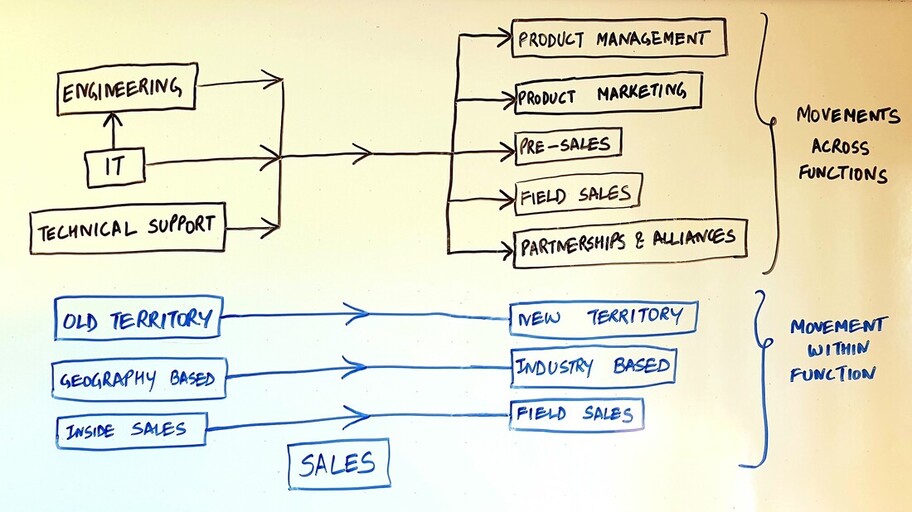Cross-Functional Movement
Cross-functional movement is an overlooked and under-appreciated team strategy. Have a look at the above picture. Each leaf represents the different abilities of an individual. It is akin to focusing on one leaf and ignoring the rest. Creating a culture of cross-functional movement within startups at any stage is beneficial. It allows founders to leverage hidden human potential. Team spirit, comfort and longevity rise. Hiring and retention costs decrease. More time becomes available for higher impact startup activities.
As a contrarian strategy, there are well-known companies that don't encourage such movement. They have an up-or-out policy. This strategy works well when your company has serious leverage in attracting talent. Even the most successful startups can't sustain this leverage beyond short periods.
Psychology as a Starting Point
Structured process and unstructured opportunities. Create a combination of these two to engage with every team member. Make it a frequent process. Understand every team member as an individual. Their underlying motivations will surprise you. Splitting the team members in two categories based on their desires is a good starting point:
It is a good idea to do an assessment exercise for all team members after every funding stage. Make it a codified process. This will enable the founders and leaders to have a continuous feel of the pulse. And morphing ambitions of team members. As a caution, do communicate that one shouldn't be switching functions too soon or too often. If this happens, benefits turn detrimental.
Preparation for New Role
From the very beginning, form cross-functional teams for all decision-making within your startup. This will enable visibility and comfort for team members. And a higher appreciation of other functions. I'll expand more on cross-functional teams in a later note.
Preparation for cross-functional movement is a two-step process:
The successful movement of a team member to a new function will take a few months of concentrated effort. As a founder, you should be willing to deal with imperfection during this stage.
Structured Passage for Movements
You may approach these movements in three structured ways:
Successful Examples of Functional Movements
Here are some examples from the above mentioned three-pronged approach. All have worked out well from early-stage startups to IPO:
As a contrarian strategy, there are well-known companies that don't encourage such movement. They have an up-or-out policy. This strategy works well when your company has serious leverage in attracting talent. Even the most successful startups can't sustain this leverage beyond short periods.
Psychology as a Starting Point
Structured process and unstructured opportunities. Create a combination of these two to engage with every team member. Make it a frequent process. Understand every team member as an individual. Their underlying motivations will surprise you. Splitting the team members in two categories based on their desires is a good starting point:
- Desire for Change: Team members who would like to explore a new function at some point. It is human nature to crave change for fulfillment. Don't resist it. Get to know why they would like to explore cross-functional movement. Make notes on their current abilities and needs for future transition. This will help you work with them during the transition phase.
- Desire for Consistency: Team members who like consistency and visibility. They want to do one function for a long time. Either as an individual contributor or leading other team members. I'll write more about each of these two subsets in later notes. I've done both roles and have equal love for each. Individual contributors with honed skills become sought-after masters of their craft. Leaders are the glue and catalyst towards scaling.
It is a good idea to do an assessment exercise for all team members after every funding stage. Make it a codified process. This will enable the founders and leaders to have a continuous feel of the pulse. And morphing ambitions of team members. As a caution, do communicate that one shouldn't be switching functions too soon or too often. If this happens, benefits turn detrimental.
Preparation for New Role
From the very beginning, form cross-functional teams for all decision-making within your startup. This will enable visibility and comfort for team members. And a higher appreciation of other functions. I'll expand more on cross-functional teams in a later note.
Preparation for cross-functional movement is a two-step process:
- Find out the team member(s) who desires change. Involve them as part of a cross-functional team. This would be a low-friction way to give them first-hand exposure. And it happens within the comfort of their working environment.
- Once the team member is ready to transition, use shadowing. It is a great way to reduce the ramp-up time and your effort towards this transition.
The successful movement of a team member to a new function will take a few months of concentrated effort. As a founder, you should be willing to deal with imperfection during this stage.
Structured Passage for Movements
You may approach these movements in three structured ways:
- First is changing responsibility within the current functional role. Least effort and lowest risk.
- Second would be a clean lateral move, i.e., moving to a new function. More effort and medium risk.
- Third is hiring team members from outside the startup world with a role change. Highest effort and highest risk. Though this opens up a wider hiring base. My earlier note, Building Comfort with Sales, covers some of these transitions.
Successful Examples of Functional Movements
Here are some examples from the above mentioned three-pronged approach. All have worked out well from early-stage startups to IPO:
Form a few guiding principles for team members right when you start the startup. Ruthless reduction of layers and hierarchy among teams. Flat team structure with compensation variance based on contribution. An environment to bring out the best among every individual team member. Cross-functional movements can help achieve all these.
My career is a microcosm of everything written above. I'm a deep believer in leveraging human talent over a lifetime.
My career is a microcosm of everything written above. I'm a deep believer in leveraging human talent over a lifetime.
Let's Talk: If you have a true experience that resonates, please send me an email.
#startup #founders #startupfounders #startupjourney #startupstories #startupsuccess #lessonslearnt #crossfunctionalmovement #careertransition #careergrowth #changecareer #engineering #it #technicalsupport #sales #productmanagement #productmarketing #presales #fieldsales #partnerships #alliances

